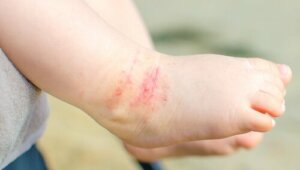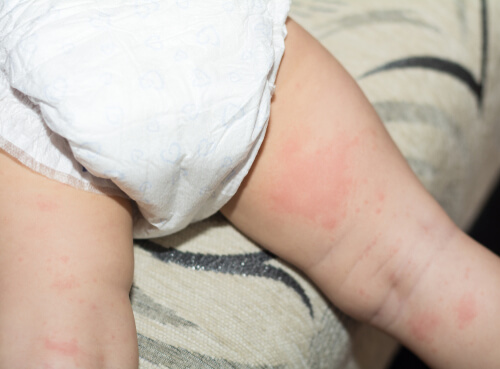All You Need to Know About Dermatitis

Dermatitis is an allergic skin reaction that causes symptoms such as:
- Redness of the skin
- Itching or pruritus
- Flaking
- Formation of blisters filled with clear fluid, which can appear in certain areas of the body
This disease can appear at any age. In the case of babies, it can develop due to an allergy, contact of the diaper with the skin, irritation due to sweat, or contact with any foreign substance. In other cases, it can be caused by:
- Side effects medications
- Poor blood circulation
- Very dry skin
This pathology doesn’t always have a cure; its treatment depends on the cause. Normally, the treatment is carried out with medications or creams prescribed by the dermatologist.
Risk factors
There are many risk factors for developing dermatitis and, depending on these, we can even develop a specific type of disease:
- Age: It can occur at any age, but atopic dermatitis or eczema is more common during breastfeeding.

- Allergies and Asthma: People with a history of eczema, allergies, seasonal allergic rhinitis, or asthma are more likely to develop atopic dermatitis.
- Occupation: Jobs where there’s contact with metals, solvents, or cleaning supplies increase the risk of contact dermatitis. Working in the healthcare setting is also associated with eczema.
- Diseases: There’s a risk of seborrheic dermatitis in the presence of some diseases, such as congestive heart failure, Parkinson’s disease, or HIV.
Classification of dermatitis
The main types of dermatitis are identified according to their clinical manifestations. These can be divided as follows:
1. Atopic dermatitis
Atopic dermatitis is a type of chronic dermatitis. It’s characterized by grayish-red lesions that are itchy and sometimes peeling, especially in skin folds.
This can be controlled with antihistamine medications, such as loratadine or cetirizine, and moisturizers or steroids, such as betamethasone. Medications should always be used under medical supervision.
2. Seborrheic dermatitis
Seborrheic dermatitis is a type of inflammation that causes redness or scaling of the skin, especially on the scalp. It is also known as seborrhea or dandruff. It’s treated with:
- Anti-dandruff shampoo
- Ointments that help regenerate and hydrate the skin
- Corticosteroid ointments

3. Dermatitis herpetiformis
Dermatitis herpetiformis is caused by gluten intolerance. It’s characterized by small blisters that cause a severe burning sensation and itching. Treatment is via a gluten-free diet and ingestion of medications such as Dapsone.
4. Ocher dermatitis
Ocher dermatitis is characterized by a dark or brown color on the legs and ankles, generally associated with the presence of varicose veins. Treatment is usually non-pharmacological. Antithrombotic measures are used such as:
- Rest
- Use of elastic stockings
- Elevation of the legs
5. Contact dermatitis
This is characterized by the appearance of blisters, itching, and redness in areas of the skin that were in direct contact with an irritating substance. Part of the treatment is to avoid contact between the skin and the allergenic substance.
6. Exfoliative dermatitis
This is one of the most serious forms of dermatitis. It’s characterized by the appearance of large areas of flaking and redness on the chest, arms, feet, or legs. Generally, it’s necessary for the individual to be hospitalized in order to apply corticosteroids, such as betamethasone or dexamethasone, intravenously.
Other types
In addition to the types described above, there are still other common types of dermatitis, which are:
- Due to the use of diapers: This is known as diaper rash. It’s characterized by irritation of the baby’s skin covered by the diaper, due to its contact with the plastic of the diaper.
- Perioral: This is characterized by the appearance of irregular pink or red spots on the skin or around the mouth. It’s most common in women between the ages of 20 and 45.
- Numular: Consists of the appearance of rounded spots that burn and itch. Later, they evolve into blisters and then to scabs. This is because the skin becomes dry. Sometimes it’s also due to bacterial infections, which can be treated with antibiotics, creams, and corticosteroid injections.
It’s always recommended to consult a dermatologist to make the correct diagnosis of the problem and to indicate the appropriate treatment.
When to see your doctor
Consult your doctor, especially in the following cases:
- You feel so uncomfortable that sleeping hours and daily activities are affected
- Your skin hurts
- You suspect that the skin is infected
- You have taken self-care measures and got no results.
Prevention
- Take a short bath or shower. Make the shower or bath last 5-10 minutes and use warm water instead of hot. Bath oil can also be helpful.
- Use cleaning products that don’t contain soap or that contain mild soaps. Choose cleaning products that are soap and fragrance-free. Some soaps can dry out your skin.
- Dry yourself carefully. After bathing, pat your skin dry quickly by rubbing it with the palms of your hands or using a soft towel and patting yourself dry.
- Moisturizes the skin. While the skin is still wet, moisturize it with oil or cream. Try different products until you find the best one for you. Ideally, the best product will be one that is safe, effective, affordable, and fragrance-free.
Dermatitis is an allergic skin reaction that causes symptoms such as:
- Redness of the skin
- Itching or pruritus
- Flaking
- Formation of blisters filled with clear fluid, which can appear in certain areas of the body
This disease can appear at any age. In the case of babies, it can develop due to an allergy, contact of the diaper with the skin, irritation due to sweat, or contact with any foreign substance. In other cases, it can be caused by:
- Side effects medications
- Poor blood circulation
- Very dry skin
This pathology doesn’t always have a cure; its treatment depends on the cause. Normally, the treatment is carried out with medications or creams prescribed by the dermatologist.
Risk factors
There are many risk factors for developing dermatitis and, depending on these, we can even develop a specific type of disease:
- Age: It can occur at any age, but atopic dermatitis or eczema is more common during breastfeeding.

- Allergies and Asthma: People with a history of eczema, allergies, seasonal allergic rhinitis, or asthma are more likely to develop atopic dermatitis.
- Occupation: Jobs where there’s contact with metals, solvents, or cleaning supplies increase the risk of contact dermatitis. Working in the healthcare setting is also associated with eczema.
- Diseases: There’s a risk of seborrheic dermatitis in the presence of some diseases, such as congestive heart failure, Parkinson’s disease, or HIV.
Classification of dermatitis
The main types of dermatitis are identified according to their clinical manifestations. These can be divided as follows:
1. Atopic dermatitis
Atopic dermatitis is a type of chronic dermatitis. It’s characterized by grayish-red lesions that are itchy and sometimes peeling, especially in skin folds.
This can be controlled with antihistamine medications, such as loratadine or cetirizine, and moisturizers or steroids, such as betamethasone. Medications should always be used under medical supervision.
2. Seborrheic dermatitis
Seborrheic dermatitis is a type of inflammation that causes redness or scaling of the skin, especially on the scalp. It is also known as seborrhea or dandruff. It’s treated with:
- Anti-dandruff shampoo
- Ointments that help regenerate and hydrate the skin
- Corticosteroid ointments

3. Dermatitis herpetiformis
Dermatitis herpetiformis is caused by gluten intolerance. It’s characterized by small blisters that cause a severe burning sensation and itching. Treatment is via a gluten-free diet and ingestion of medications such as Dapsone.
4. Ocher dermatitis
Ocher dermatitis is characterized by a dark or brown color on the legs and ankles, generally associated with the presence of varicose veins. Treatment is usually non-pharmacological. Antithrombotic measures are used such as:
- Rest
- Use of elastic stockings
- Elevation of the legs
5. Contact dermatitis
This is characterized by the appearance of blisters, itching, and redness in areas of the skin that were in direct contact with an irritating substance. Part of the treatment is to avoid contact between the skin and the allergenic substance.
6. Exfoliative dermatitis
This is one of the most serious forms of dermatitis. It’s characterized by the appearance of large areas of flaking and redness on the chest, arms, feet, or legs. Generally, it’s necessary for the individual to be hospitalized in order to apply corticosteroids, such as betamethasone or dexamethasone, intravenously.
Other types
In addition to the types described above, there are still other common types of dermatitis, which are:
- Due to the use of diapers: This is known as diaper rash. It’s characterized by irritation of the baby’s skin covered by the diaper, due to its contact with the plastic of the diaper.
- Perioral: This is characterized by the appearance of irregular pink or red spots on the skin or around the mouth. It’s most common in women between the ages of 20 and 45.
- Numular: Consists of the appearance of rounded spots that burn and itch. Later, they evolve into blisters and then to scabs. This is because the skin becomes dry. Sometimes it’s also due to bacterial infections, which can be treated with antibiotics, creams, and corticosteroid injections.
It’s always recommended to consult a dermatologist to make the correct diagnosis of the problem and to indicate the appropriate treatment.
When to see your doctor
Consult your doctor, especially in the following cases:
- You feel so uncomfortable that sleeping hours and daily activities are affected
- Your skin hurts
- You suspect that the skin is infected
- You have taken self-care measures and got no results.
Prevention
- Take a short bath or shower. Make the shower or bath last 5-10 minutes and use warm water instead of hot. Bath oil can also be helpful.
- Use cleaning products that don’t contain soap or that contain mild soaps. Choose cleaning products that are soap and fragrance-free. Some soaps can dry out your skin.
- Dry yourself carefully. After bathing, pat your skin dry quickly by rubbing it with the palms of your hands or using a soft towel and patting yourself dry.
- Moisturizes the skin. While the skin is still wet, moisturize it with oil or cream. Try different products until you find the best one for you. Ideally, the best product will be one that is safe, effective, affordable, and fragrance-free.
- Moreno, R. A., & Peiró, P. S. (2000). Atopic dermatitis. Medicina Naturista. https://doi.org/10.1542/pir.2016-0169
- Emanuel, S., & Hawarden, D. (2018). Dermatitis. Current Allergy and Clinical Immunology. https://doi.org/10.1016/B978-141600087-7.50127-6
- Svecova, D., & Nemsovska, J. (2015). Contact dermatitis. In Contact Dermatitis. https://doi.org/10.1007/978-3-319-29785-9_23
Este texto se ofrece únicamente con propósitos informativos y no reemplaza la consulta con un profesional. Ante dudas, consulta a tu especialista.







